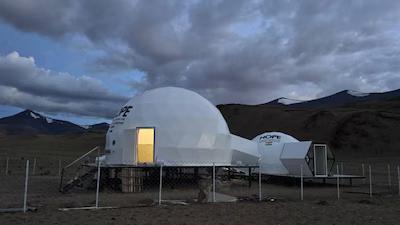
ISRO Sets Up Station in Ladakh to Simulate Life on Moon & Mars
India’s space agency, the Indian Space Research Organisation (ISRO), has taken a significant step towards exploring the vast expanse of space by setting up a unique simulation facility in Ladakh’s Tso Kar Valley. The Himalayan Outpost for Planetary Exploration (HOPE) is a 10-day simulation mission designed to test life-support systems for future lunar and Martian missions. The facility was inaugurated on August 1, with two crew members undertaking various tests at the station for the next 10 days.
The Tso Kar Valley, located at an altitude of over 15,000 feet, was chosen for its extreme and unique environment, which closely resembles that of Mars. The valley experiences high UV radiation, low atmospheric pressure, extreme cold, and saline permafrost, making it an ideal location to test the endurance of life-support systems and crew members.
The HOPE simulation mission is a crucial step towards India’s ambitious plans to send humans to the Moon and Mars in the near future. ISRO has been working on developing technologies and systems required for such missions, and this simulation exercise will help test the feasibility of life-support systems, including food, water, and air supply, in a Martian-like environment.
During the 10-day simulation, the two crew members will be living in isolation at the HOPE facility, with limited communication and supplies. They will have to rely on the life-support systems, which will be tested for their efficiency and effectiveness in providing basic necessities such as food, water, and air. The crew members will also be engaged in various scientific experiments, such as studying the effects of high altitude and UV radiation on the human body.
The HOPE facility has been designed to mimic the conditions on Mars, with a controlled environment that simulates the Martian atmosphere, temperature, and humidity. The facility is equipped with state-of-the-art equipment and technology, including a life-support system, a communication system, and a medical bay.
The simulation mission is not only crucial for testing the life-support systems but also for understanding the psychological and physiological effects of long-duration space travel on the human body. The crew members will be monitored closely by scientists and medical professionals, who will study their behavior, physical and mental health, and overall well-being during the simulation.
The HOPE simulation mission is a significant achievement for ISRO, which has been working tirelessly to develop its capabilities in space exploration. The organization has already achieved several milestones, including the successful launch of the Chandrayaan-1 mission to the Moon and the Mangalyaan mission to Mars.
The success of the HOPE simulation mission will pave the way for India’s ambitious plans to send humans to the Moon and Mars in the near future. ISRO is planning to launch its first manned mission to the Moon, called Chandrayaan-3, in 2023, followed by a mission to Mars in the 2020s.
The HOPE simulation mission is a testament to India’s commitment to space exploration and its willingness to take bold steps towards realizing its ambitions. The mission will not only provide valuable insights into the challenges of long-duration space travel but also demonstrate India’s capabilities in developing cutting-edge technologies and systems required for space exploration.






